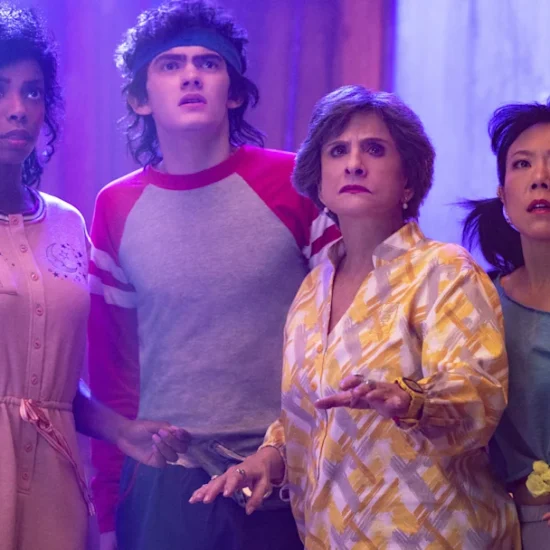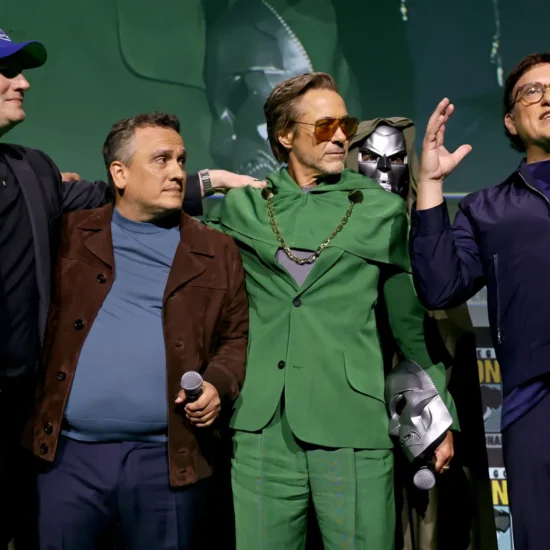
“Barbie” (Warner Bros.) grossed $155 million domestic and $182 million foreign. “Oppenheimer” (Universal) grossed $80.5 million domestic and $93.7 million foreign. Two non-franchise films, released on the same weekend, from two proven directors allowed their voices loud and clear despite $100 million+ budgets. That’s mega.
We all know that prefix — it’s Greek for “millions” — but the rise of atomic bomb testing in the 1950s introduced “mega” into daily use. It referred to the power of TNT expressed as megatons, or a million tons of TNT. It also implied massive impact or damage — and that’s acutely true here.
“Oppenheimer” and “Barbie” have damaged the studio truisms that surround moviemaking. The franchises, the familiar execution, the drive to develop IP that can be replicated — all those reliable touchstones that Wall Street loves — suddenly, those models look a little albatross-y. Audiences are less interested in commodities, no matter how expensive and bombastic.
Studios have a game-changing opportunity to channel the audience’s passion, now. Perhaps they might consider coming to terms with the writers, who could offer their thoughts?
“Barbie” had the year’s biggest domestic opening weekend, but “The Super Mario Bros. Movie” opened on a Wednesday and grossed $52 million ahead of its $146 million weekend for a $204 million total. “Barbie” could reach parity by Tuesday, although that’s a tall order at $30 million per day.
This weekend’s box office total of over $300 million is rare. It’s the best since 2019 when “Avengers: Endgame” propelled a total over $400 million. Suddenly, the summer is $10 million ahead of 2022 when last week it was down six percent.
Year-to-date now stands at 16 percent over 2022. If that continues, the year would end at $8.6 billion — impact of the SAG-AFTRA and WGA strikes notwithstanding.
Even adjusted for inflation, Greta Gerwig has the biggest opening weekend for a film directed solely by a woman. (“Captain Marvel,” co-directed by Anna Boden in 2019 opened to $153 million. That would be higher today, although it had the advantage of very little competition).
“Oppenheimer” is R-rated, three hours long, and is helped by higher ticket prices and hurt by less availability. Christopher Nolan overcame all of that, not to mention a story that isn’t clearly commercial.

“Oppenheimer”
However, the best comp for this weekend’s top films may be “Bonnie and Clyde” and “Easy Rider” — films that defied the late-1960s model and put studios on notice that their businesses were no longer keeping pace with the audience. Granted, they were low-budget wonders and no one would say that of Gerwig and Nolan’s films — but they cost a lot less than their franchise competitors.
Underlining this conclusion is the fate of “Mission: Impossible — Dead Reckoning Part One” (Paramount). Sure, we can nitpick strategic choices (a two-part film this late in the franchise, the choice of date), but this was expected to be easily a $300 million domestic/$700 million worldwide or better success. It felt as sure as any release this summer.
Instead, after opening below expectations, it dropped 64 percent. It lost premium screens (despite Tom Cruise’s valiant efforts), but the bigger challenges were competition far greater than anyone anticipated — and, like “Indiana Jones and the Dial of Destiny” (Disney) before it, and audiences are losing their appetite for retreads no matter the execution.
“Mission,” like “Barbie” and “Oppenheimer,” received an A Cinemascore and Metacritic scores above 80. It is this summer’s seventh franchise release with at least three previous entries (for “Mission,” #7). At least three of this summer’s franchise films cost around $300 million before marketing. That’s a massive bet on a fading model.
Per estimates, “Mission” is #4 this weekend at $19.5 million, just below “Sound of Freedom” (Angel). The sleeper success starring Jim Caviezel reports $124 million so far. Other studios believe that “Mission” edged “Sound” for the weekend, but the actual rank here is a detail; that they are even close is the story.

As expected, “Mission” continues to perform better in foreign markets. Of its $372 million haul so far, 68 percent comes from overseas. The same factors figure in (new competition, loss of some premium screens, franchise fatigue) and this looks like a potential $600 million global take. If so, that’s down from 2018’s $791 million for “Fallout.”
This weekend’s earth-shattering results come at a precarious time. The rest of this summer has much stronger lineup than last year, but the lack of star promotion will hurt. Already there are signs that studios may delay some films.
Shifting release schedules create new parameters and as productions delay, it makes sense to rearrange titles to cover the gaps. Anything that steps in the way of this potentially huge rebound hurts theaters and the studios’ delay tactics might be done without due consideration.
There are vital models beyond Gerwig’s and Nolan’s. Look at the long-term success of Quentin Tarantino, while Jordan Peele is an amazing voice who keeps making standout films based on nothing but his creative skills. There are more out there. And their movies cost less.
With studio films competing for sophisticated viewers, it’s tough to launch more limited films. Consider Searchlight’s “Theater Camp.” It expanded to 51 theaters and grossed $266,000 (per theater $5,200); it has mostly prime locations in these initial cities. What remains to be seen is if the initial audience response shows dividends as it rolls out. Whatever the results, this weekend should show Disney execs how important it is to have a unit that is making non-franchise titles.
The Top 10
1. Barbie (Warner Bros. Discovery) NEW – Cinemascore: A; Metacritic: 81; Est. budget: $145 million
$155,000,000 in 4,243 theaters; PTA (per theater average): $36,531; Cumulative: $155,000,000
2. Oppenheimer (Universal) NEW – Cinemascore: A; Metacritic: 90; Est. budget: $100 million
$80,500,000 in 3,610 theaters; PTA: $22,299; Cumulative: $80,500,000
3. Sound of Freedom (Angel) Week 3; Last weekend #2
$20,141,000 (-26%) in 3,265 in 3,285 (+20) theaters); PTA: $6,131; Cumulative: $124,749,000
4. Mission: Impossible — Dead Reckoning: Part One (Paramount) Week 2; Last weekend #1
$19,500,000 (-64%) in 4,321 (- 6) theaters; PTA: $4,513; Cumulative: $118,753,000
5. Indiana Jones and the Dial of Destiny (Disney) Week 4; Last weekend #4
$6,700,000 (-45%) in 2,885 (-980) theaters; PTA: $2,322; Cumulative: $159,019,000
6. Insidious: The Red Door (Sony) Week 3; Last weekend #3
$6,500,000 (-50%) in 2,544 (-634) theaters; PTA: $2,545; Cumulative: $71,002,000
7. Elemental (Disney) Week 6; Last weekend #5
$5,800,000 (-36%) in 2,720 (-515) theaters; PTA: $2,132; Cumulative: $137,234,000
8. Spider-Man: Across the Spider-Verse (Sony) Week 8; Last weekend #6
$2,815,000 (-53%) in 1,669 (-908) theaters; PTA: $1,687; Cumulative: $375,209,000
9. Transformers: Rise of the Beasts (Paramount) Week 7; Last weekend #7; also on PVOD
$1,120,000 (-67%) in 834 (-1,207) theaters; PTA: $1,343; Cumulative: $155,643,000
10. No Hard Feelings (Sony) Week 5; Last weekend #8
$1,075,000 (-67%) in 1,017 (-1,036) theaters; PTA: $1,037; Cumulative: $49,211,000
Other specialized titles
Films (limited, expansions of limited, as well as awards-oriented releases) are listed by week in release, starting with those opened this week; after the first two weeks, only films with grosses over $5,000 are listed.
Theater Camp (Searchlight) Week 2
$266,000 in 51 (+45) theaters; PTA: $5,200; Cumulative: $471,487
Afire (Janus/Sideshow) Week 2
$26,450 in 8 (+5) theaters; PTA: $3,306; Cumulative: $80,301
The Miracle Club (Sony Pictures Classics) Week 2 678
$190,192 in 271 (-407) theaters; PTA: $702 ; Cumulative: $1,351,000
Lakota Nation vs. United States (IFC) Week 2
$3,500 in 2 (+1) theater; PTA: $1,750; Cumulative: $15,000
Have You Got It Yet? (Abramorama) Week 2 1
$8,652 in 3 (+2) theaters; PTA: $2,883; Cumulative: $17,989
Past Lives (A24) Week 6
$166,361 in 176 (-210) theaters; Cumulative: $10,042,000
Monica has a BA in Journalism and English from the University of Massachusetts and an MS in Journalism and Communications from Quinnipiac University. Monica has worked as a journalist for over 20 years covering all things entertainment. She has covered everything from San Diego Comic-Con, The SAG Awards, Academy Awards, and more. Monica has been published in Variety, Swagger Magazine, Emmy Magazine, CNN, AP, Hidden Remote, and more. For the past 10 years, she has added PR and marketing to her list of talents as the president of Prime Entertainment Publicity, LLC. Monica is ready for anything and is proudly obsessed with pop culture.














